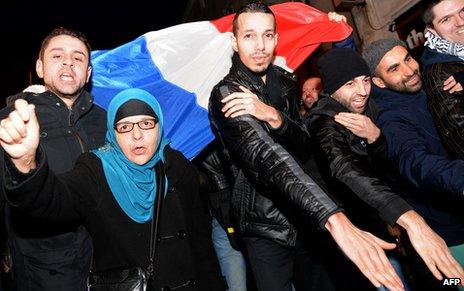Who, What, Why: What is the quenelle gesture?
- Published

Anelka (right) said the sign was a "dedication" to comedian Dieudonne
French footballer Nicolas Anelka has denied accusations of anti-Semitism after celebrating a goal by performing a controversial hand gesture known as a "quenelle". What is it?
The gesture involves touching or gripping your shoulder with one hand while holding the palm of your other hand outstretched and pointing to the ground. Some describe it as a combination of the bras d'honneur with a bent arm (which means "up yours") and the Nazi salute.
It is the trademark of the hugely controversial French comedian Dieudonne M'Bala M'Bala, who once said he would like to put a quenelle - a rugby-ball-shaped serving of fish or meat paste - up the backside of Zionists.
Dieudonne made the gesture when he headed his own anti-Zionist campaign in the European elections in 2009. French media trace it further back, to one of his performances in 2005. It came to greater prominence in September when two soldiers were photographed appearing to make the gesture outside a Paris synagogue.
There are thousands of examples posted online, some at sensitive sites such as the Auschwitz death camp, and Dieudonne's fans can be seen repeating it outside his theatre.

West Bromwich Albion striker Anelka said on Twitter, external it was dedicated to his "comedian friend" - who has been convicted of making anti-Semitic remarks and now faces a ban on public appearances. Both Anelka and Dieudonne say it is an anti-establishment symbol of defiance. But the French sports minister, Valerie Fourneyron, was one of many to disagree with the footballer's interpretation, saying it was sickening and incited racial hatred.
Jean-Yves Camus, a French academic who studies the extreme right, told the Independent, external the quenelle has become a "badge of identity, especially among the young, but it is doubtful that all of them understand its true meaning". He says Dieudonne has become the hero of a movement convinced the world is run by Washington and Tel Aviv.
"I think it's likely to be more complex than just being associated with the far right," says Jim Shields of Aston University, an expert on the French far right, because Dieudonne has been involved with anti-racist left-wing activists as well as far-right activists. "At the moment, the use of this gesture seems too diffuse to fit any simple right-left interpretation."
Anelka is not the first French footballer playing in England to make the gesture. Samir Nasri and Mamadou Sakho were also photographed in this way, although Sakho later tweeted, external that he had been tricked and didn't realise its true meaning.
Reporting by Tom Geoghegan
Follow @BBCNewsMagazine, external on Twitter and on Facebook, external
On a tablet? Read 10 of the best Magazine stories from 2013 here